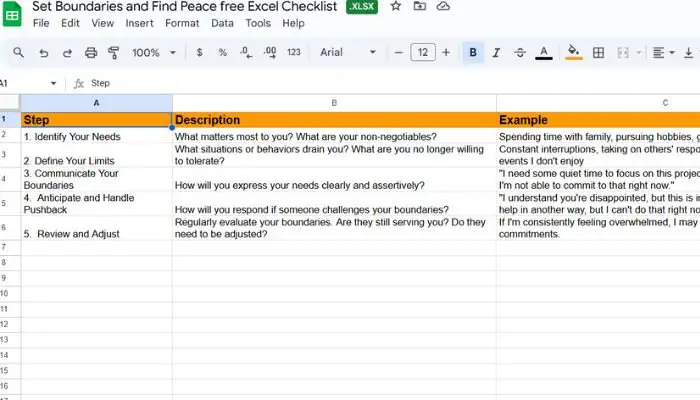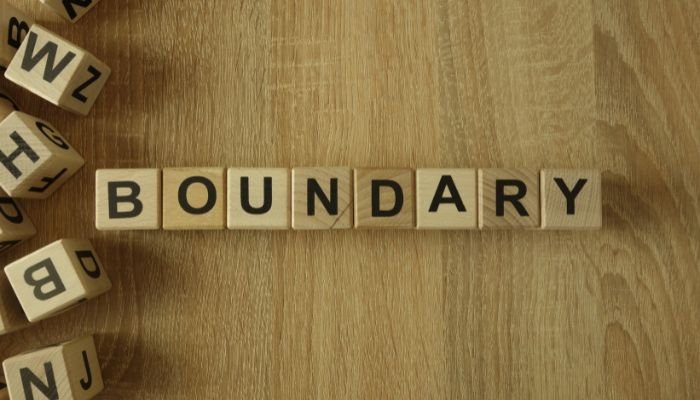Disclaimer: This post may contain affiliate links, meaning we get a small commission if you make a purchase through our link at no extra cost to you. For more information, please visit our Disclaimer Page.
Feeling overwhelmed by the constant juggle of work, family, and personal life?
You’re not alone. Learning how to set boundaries and find peace is essential for reclaiming your time, energy, and well-being.
Boundaries are like invisible fences that protect your inner peace, allowing you to say “no” without guilt and prioritize what truly matters.
When you create healthy boundaries, you create space for yourself to thrive, both personally and professionally.
It’s about honoring your needs, communicating effectively, and saying “yes” to a more balanced and fulfilling life.
Different Types of Boundaries
1. Physical Boundaries These boundaries protect your body and personal space. They are essential for creating a sense of comfort and security. Some examples include:
- Avoiding unnecessary physical contact with people, particularly in work or public settings.
- Setting limits on when and where you’re comfortable being touched, whether by friends, family, or colleagues.
- Choosing to maintain a safe physical distance when you’re not comfortable in a particular space.
2. Emotional Boundaries These protect your feelings and emotional energy. They allow you to safeguard your mental well-being without letting others’ emotions overwhelm yours. Examples:
- Not absorbing other people’s stress or negative emotions.
- Recognizing that you can’t “fix” everyone’s problems.
- Allowing yourself to say no when a relationship becomes emotionally draining.
3. Mental Boundaries These protect your thoughts, opinions, and values. They’re key in helping you maintain individuality and clarity. For example:
- Respecting your need for personal time and space to reflect, plan, and think.
- Setting limits on discussions around topics that challenge your beliefs unless you’re open to having them.
- Recognizing when it’s time to walk away from a conversation that undermines your views or self-worth.
4. Material Boundaries These involve protecting your physical belongings and finances. They’re crucial in fostering respect for your possessions and your financial well-being. Examples include:
- Refusing to lend money or possessions unless you’re truly comfortable with it.
- Setting clear expectations with others about the use of your personal belongings.
- Creating boundaries around your spending to maintain a healthy budget.
5. Time Boundaries These boundaries help you protect your most valuable asset—your time. By setting these, you can better balance work, personal activities, and relaxation. Examples include:
- Not overcommitting to events or activities, especially when you need time for yourself.
- Saying no to requests that interfere with your priorities or obligations.
- Allocating specific times for work, hobbies, and rest, and sticking to them.
Boundaries in Specific Situations
Dealing with Difficult People Difficult interactions with people can cause stress and take a toll on your well-being. To set boundaries in these situations:
- Limit the time spent with negative or toxic individuals.
- Practice assertiveness—politely yet firmly tell them what is and isn’t acceptable in your presence.
- Use the “broken record technique,” where you calmly repeat your boundary if they try to push it.
Boundaries in Family Relationships Family dynamics can sometimes blur the lines when it comes to respecting personal boundaries. To protect yourself while maintaining healthy family relationships:
- Set limits around how often you engage in family obligations, especially if they leave you feeling emotionally drained.
- Be clear about your values, and don’t let family members push you into actions or decisions that don’t align with them.
- Take breaks when needed, especially during stressful family gatherings.
Boundaries with Technology In our hyper-connected world, setting boundaries with technology is essential to maintain your mental peace. This includes:
- Scheduling regular “screen-free” times during the day to disconnect from emails, social media, and work notifications.
- Setting privacy settings on social media to protect personal information.
- Limiting exposure to digital content that feels overwhelming or mentally draining.
The Benefits of Setting Boundaries
- Improved Self-Awareness: Knowing what you need allows you to live more authentically.
- Increased Assertiveness: Clear boundaries lead to better communication and less self-doubt.
- Greater Self-Respect: By standing firm in your limits, you develop a deeper respect for yourself and your needs.
- Reduced Stress and Anxiety: Boundaries help you manage emotional and mental energy, leading to a calmer, less reactive life.
- Stronger Relationships: Healthy boundaries foster mutual respect, trust, and understanding.
- Better Mental Health: By not overextending yourself, you protect your emotional well-being and build resilience.
Advanced Boundary-Setting Techniques
- The Broken Record Technique: This involves calmly and consistently repeating your boundary when someone challenges it. It’s especially useful in difficult or confrontational situations.
- Setting Consequences: Be clear about the consequences if someone crosses your boundaries. For example, you might say, “If you continue to interrupt me, I’ll have to end this conversation.”
- Saying No Without Guilt: Saying no doesn’t make you selfish; it makes you wise. Practice saying no in a way that feels natural and unapologetic. It might feel uncomfortable at first, but with practice, it becomes easier.
Signs You Need Better Boundaries
- You often feel exhausted or resentful after socializing or helping others.
- You struggle to say no, even when it negatively impacts you.
- You feel overwhelmed or drained by the demands of others.
- You feel guilty when you prioritize yourself or your needs.
- You constantly put others’ needs ahead of your own.
How to Set Boundaries Without Feeling Guilty
1. Get Clear on Your Limits
Identify areas in your life where you feel drained or overwhelmed. What needs to change? Be honest with yourself about what’s working and what isn’t.
2. Communicate Assertively
Use clear, direct language when stating your boundaries. Instead of saying, “I don’t think I can help,” say, “I’m unable to assist with that at this time.”
3. Start Small
Start setting small boundaries in less challenging situations. This can build your confidence and make it easier to set bigger boundaries later.
4. Prepare for Pushback
Not everyone will respect your boundaries right away. Be patient, but firm. Remain consistent, and don’t feel compelled to explain yourself repeatedly.
5. Follow Through
Once you’ve set a boundary, stick to it. Letting someone violate your boundary once sends a signal that it’s negotiable.
Affirmations to Strengthen Your Boundaries
Repeating affirmations can help you solidify your boundaries and reinforce your commitment to protecting your well-being. Here are 20 affirmations to empower you:
- “I have the right to say no without guilt.”
- “My needs and desires are just as important as anyone else’s.”
- “I honor my time and my energy by setting clear boundaries.”
- “It’s okay to put myself first.”
- “I am worthy of respect, and I will protect my peace.”
- “Setting boundaries allows me to build stronger, healthier relationships.”
- “I trust myself to make decisions that honor my well-being.”
- “I release the need to please everyone.”
- “I am in control of my time and how I spend it.”
- “My boundaries are not walls; they are bridges to healthier connections.”
- “I create space in my life for what truly matters to me.”
- “Saying no is an act of self-love and respect.”
- “I am worthy of love, respect, and understanding from others.”
- “It’s safe for me to express my needs and desires.”
- “I deserve to protect my peace from negativity and drama.”
- “I set boundaries to protect my mental, emotional, and physical health.”
- “I am confident in my ability to uphold my boundaries.”
- “I give myself permission to take breaks and recharge.”
- “Boundaries are a form of self-respect and self-care.”
- “I am creating a life that aligns with my values and desires.”
Tools to Help You Set Boundaries
To support you in your boundary-setting journey, here are some helpful resources:
- Boundary-Setting Checklist: A guide to identify and establish your personal boundaries.
- Scripts for Saying No: Pre-written phrases to help you communicate boundaries with ease and confidence.
- Self-Assessment Quiz: A tool to assess how well you’re respecting your own boundaries and where improvements can be made.

Set Boundaries and Find Peace free Excel Checklist
| Step | Description | Example |
|---|---|---|
| 1. Identify Your Needs | What matters most to you? What are your non-negotiables? | Spending time with family, pursuing hobbies, getting enough sleep |
| 2. Define Your Limits | What situations or behaviors drain you? What are you no longer willing to tolerate? | Constant interruptions, taking on others’ responsibilities, attending social events I don’t enjoy |
| 3. Communicate Your Boundaries | How will you express your needs clearly and assertively? | “I need some quiet time to focus on this project.” “I appreciate your offer, but I’m not able to commit to that right now.” |
| 4. Anticipate and Handle Pushback | How will you respond if someone challenges your boundaries? | “I understand you’re disappointed, but this is important to me.” “I’m happy to help in another way, but I can’t do that right now.” |
| 5. Review and Adjust | Regularly evaluate your boundaries. Are they still serving you? Do they need to be adjusted? | If I’m consistently feeling overwhelmed, I may need to re-evaluate my commitments. |
Final Thoughts
Setting boundaries is a transformative practice that will help you reclaim your time, peace, and energy.
It’s an essential part of self-care, enabling you to live authentically and engage in relationships that nourish and support you.
By setting and maintaining boundaries, you’re not only protecting your well-being but also creating a life that reflects your true self.
Remember, boundaries are not about isolating yourself or rejecting others; they’re about cultivating a life of balance, respect, and fulfillment.
You have the power to decide what is acceptable in your life. Start small, be consistent, and watch your life transform.





